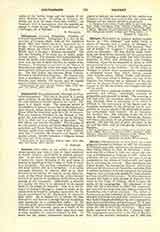

Calvary, CONGREGATION OF OUR LADY OF, a congregation founded at Poitiers, in 1617, by Antoinette of Orleans-Longueville, assisted by the famous Capuchin, Father Joseph Le Clerc du Tremblay. Antoinette was left a widow in 1596, and entered the convent of Feuillantines at Toulouse in 1599. After her profession she was commanded by the pope to act as coadjutrix to the Abbess of Fontevrault, and assist her in reforming her convent. Here Antoinette met Father Joseph, who became her director: he had just reformed the monastery of l’Encloltre, and when Paul V ordered Antoinette to found a seminary for training religious, this convent was chosen for that purpose, and was soon filled with novices. In 1614 Antoinette founded and built a new convent at Poitiers, dedicated to Our Lady of Calvary, which became the cradle of the congregation. By permission of the pope, she left Fontevrault to enter this monastery, and took with her those nuns who wished to follow the Benedictine rule in all its strictness. The Abbess of Fontevrault at first consented to this, but afterwards objected, and it was not until after Antoinette’s death that Father Joseph established the new congregation, gave them constitutions, and got Gregory XV to issue a Bull erecting them into an independent congregation under the title of Our Lady of Calvary. They were finally approved by the Holy See, January 17, 1827. The congregation succumbed to the French Revolution, but was restored afterwards and in 1860 had twenty houses in France, of which seven still exist. The mother-house is at Orleans, three convents are in Vendome, Angers, and La Capelle Marival, and in 1897 an orphanage and boarding-school were opened for girls of the Greek Rite on the Mount of Olives at Jerusalem. The life is mixed. Father Joseph ordered that there should always be a nun meditating before the crucifix day and night. The nuns have boarding-schools and take charge of deaf and dumb girls, and the old and infirm. The habit is brown with a black scapular.
FRANCESCA M. STEELE

